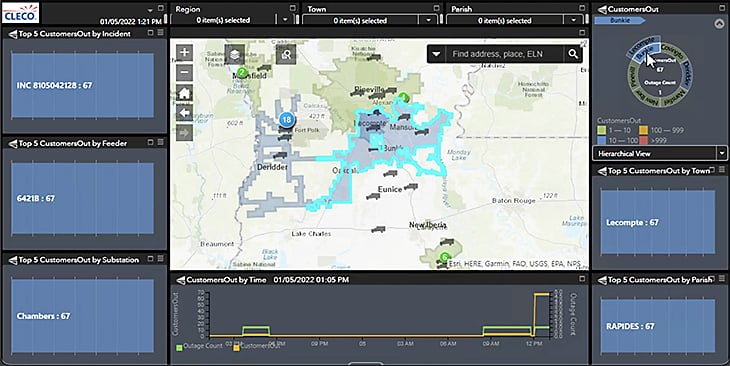With an increase in devastating weather events in recent years, many electric utilities are turning toward digital twin technology to help plan system changes and predict the impact of weather and other conditions against their electrical systems.
Following suit, Cleco recently launched its Digital Utility® dashboard using operational digital twin technology to help better manage outage operations and communications. The dashboard contains three interactive, operational views – allowing Cleco to monitor and manage outages in real-time, analyze past events to identify trends, and review reliability indices data that is truncated every three years. Using the dashboard over the past two years has helped Cleco streamline outage communications, enhance outage procedures, and prepare different emergency responses based on storm and geographic data.
Cleco – Connecting Louisiana’s Future
Headquartered in Pineville, Louisiana, Cleco Corporation has been powering Louisiana residents and businesses throughout its twenty-four-parish service territory since 1935. Through two subsidiaries, Cleco Power and Cleco Cajun, the utility delivers electricity to roughly 290,000 customers across 13,487 miles of power lines.
The utility has invested in its parishes, or counties, since the inception of the company, spanning eighty-six years. Today, Cleco continues to invest in its customers, leveraging operational digital twin technology to help keep its communities powered during and after storms. Late last year, Cleco was recognized for its dedication to this vision through its acceptance of the Rapides Regional Medical Center 2021 Community Benefit Award. Cleco was presented this award for its support of the local community and its emergency responses during major storm events, including hurricanes and winter ice storms.
In addition, Cleco has received numerous awards in areas of emergency recovery and assistance, earning 25 awards from the Edison Electric Institute (EEI) since 1998. The utility was most recently presented an Emergency Response Award in June of 2021 for power restoration following Hurricanes Delta and Zeta in 2020.
Setting the Stage for Change
Prior to Cleco’s shift from an in-house developed system to Esri’s ArcGIS Enterprise platform in 2019, a dashboard supporting real-time visualization of operational performance and spatial analytics would not have been possible. The move enabled the solution to sit directly on top of Cleco’s GIS, providing a spatial awareness aspect to the dashboard for utility assets and customers.
The shift to Esri’s platform coincided with Cleco’s move to SAP and resulted in many of the utility’s homegrown solutions for outage management to become obsolete. One such solution had allowed operations to view current outages by circuit. This information, in conjunction with other data, helped Cleco prioritize power restorations during outages. Losing the capability to view ongoing outages, operational managers were unable to determine how many of their customers were impacted by the outages, leading to difficulty when dispatching crews. “It was a little bit of chaos,” Jimmie Belgard, Supervisor of Distribution Automation at Cleco, recalls. “Once we lost that ability, we were having a hard time managing storms and managing our crews during storms.”
With native outage management solutions no longer in operation, Cleco became very interested in a dashboard with real-time and historical capabilities to help better manage and analyze outage operations – while increasing reliability for its customers before, during, and after storms.
Developing the Dashboard
Cleco’s service territory is spread across eight geographically varied regions which are overseen by seven operational managers. It was essential that the new dashboard solution serve the needs of all managers and their parishes to be successful. “We wanted to deliver the tool that our operations needed,” states Jimmie. To accomplish this, the dashboard was developed collaboratively with input from all managers. Beyond a requirement standpoint, the managers’ involvement in the development of the dashboard generated excitement about the capabilities of the application, helping to support a smooth transition to the new technology.
“When we looked at the dashboard and what was possible, what we built was a dashboard where we could see how many outages per device, per circuit, and per township and operating areas.”
Jimmie Belgard, Cleco

Different Dashboard Views
Using Cleco’s Schneider Electric ADMS data, in-house developed reliability scripts, and new GIS, UDC developed and deployed UDC’s Digital Utility® DyAN™ solution to create three interactive outage dashboard views for Cleco in early 2020 – an outage dashboard, a historical outage view dashboard, and a reliability analysis dashboard. By leveraging one solution for the different views and using the data generated from its ADMS to populate the dashboards, Cleco has provided an easily accessible and consistent format for its end-users in one visual that is shared enterprise wide.
Equipped with operational digital twin technology, the dashboard provides more operational insight for utilities than a standalone GIS – enabling utilities to take full advantage of all digital data being generated from their systems and devices. Integrated with Cleco’s SCADA, ADMS, and live feeds, the dashboard not only provides Cleco with real-world representations of its assets but also provides a readily available view of the current, past, and reliability performance of the network as well as future network forecasts.
Through interactive widgets that update and filter the dashboard views based on the user’s selection, operational managers can access data and statistics that were impossible to get before the dashboard.
“Being able to filter that data really quickly – that’s a huge advantage.”
Jimmie Belgard, Cleco
For instance, management can now determine the peak number of customers out at the exact peak time using the Historical Trend feature. According to Jimmie, “Everyone is loving that tool right now, because it was always a difficult number to come by.”
Improving Outage Communications
Before the dashboard, operational managers were unable to view the worst-hit areas and the number of impacted customers within those areas. Now, instantaneous outage information can be viewed both visually and statistically. For Jimmie, he believes this information has helped streamline operations.
“The dashboard gives us a way to break down those numbers really quickly – to look by parish, by township, by operating area, and by circuit.” Having this filterable data at its fingertips has enabled Cleco to share relevant statistics with stakeholders and public safety partners – something the utility was unable to do before. “It’s important that we’re able to look through that information quickly and be able to cycle that information. Certainly, these dashboards have helped,” Jimmie remarks.
Prior to synching Cleco’s outage data into one, consolidated dashboard and format, managers made phone calls to supervisors and crewmembers to determine truck locations and develop outage strategies. Integrated with automatic vehicle location (AVL) tracking technology, the dashboard displays which crews and supervisors are in which trucks in real-time, allowing management to move crews around more easily.
“You know exactly where your supervisors are and where your crews are. It becomes a lot easier to manage that without constantly calling people. Being able to see that data in a quick glance is very beneficial for us, and it makes us much more efficient.”
Jimmie Belgard, Cleco
Additionally, the dashboard allows operations to monitor power de-energizations and re-energizations before, during, and after storm events. With this knowledge, operational managers can determine when an area is near to full restoration, enabling seamless crew movement between outages.
Enhancing Storm Management and Planning
With summer storms ramping up over the past several years, Cleco experiences one to two major storm events a year – leaving ten to fifteen percent of its customers without power following each event. Having the ability to view the same outage data in various ways within the different dashboard views has been a valuable tool for the utility in managing these outages. “The dashboard makes us more efficient in storm restorations of any size,” says Jimmie.
The capability to analyze past storms and outages with the historic event playback functionality is helping Cleco prepare for future storms – in different ways. Through reviewing historical trends, the number of outages, and the number of impacted customers, Cleco identified that while hurricanes cause larger, widespread outages, the ratio of impacted customers to outages is much higher for ice storms.
“As you’re backing up and looking at this data at a micro level, you can really see how the trends of these storms are different. My hope is that by viewing that, we’re able to prepare for storms differently, and we’ll know what to expect next time.”
Jimmie Belgard, Cleco
The dashboard has also helped reveal how storms affect different geographic regions within Cleco’s diverse service territory. With a densely populated eastern territory and a rural western territory, Cleco’s wide-ranging set of customers and circuits requires different emergency measures from the utility. “The way that storms impact those areas are different and our response to those storms in those areas is different,” Jimmie explains. “This tool helps with managing those responses.”
Navigating the Pandemic
Deployed just as Covid-19 began making headlines in the U.S., the gravity of the timing of the dashboard was not yet realized. Now, two years into the pandemic, the dashboard has made remote work much easier for operations. “The dashboard has given us the ability to get insight on data, that before, we only had access on certain systems,” Jimmie says. “Now, we can remote into a particular network and get straight to the dashboard.” As the pandemic continues to change utility operations across the country and globally, the dashboard remains a constant at Cleco, providing reliability amid uncertainty.
Technology for the ‘Future Utility’
Along with providing invaluable insight into operational management, the dashboard also revealed abnormalities in Cleco’s data feeding the dashboard. “It really brought to light that we needed to go back and correct a lot of our outage data,” Jimmie states. Currently, Cleco is leading an effort to clean up its data to improve dashboard reliability for operations and utility customers. As a result of Cleco’s recent ADMS upgrade completed in late 2021, the utility anticipates providing its operations team with real-time metrics for momentaries directly within the dashboard.
Jimmie believes that dashboards have a big role to play in the future of utilities. That one day, utility managers will log into their operational dashboards first thing in the morning, with the same routine as getting a cup of coffee. With digital twin technology still at the infancy stage, operational dashboards may just be the beginning.
As Jimmie so concisely puts it, “Knowledge is king. Data is king.”
If you would like to learn about the dashboards implemented at Cleco in more detail, or UDC’s Digital Utility® suite of industry solutions, see Digital Twin Technology at Cleco.
